History of the rupee
The history of the Rupee traces back to ancient Indian subcontinent. The mention of rūpya by Panini is seemingly the earliest reference in a text about coins.[2] The term in Indian subcontinent was used for referring to a coin.[3]
The word "rupee" is derived from a Sanskrit word "rūpya", which means "wrought silver", and maybe also something stamped with an image or a coin.[4] As an adjective it means "shapely", with a more specific meaning of "stamped, impressed", whence "coin". It is derived from the noun rūpa "shape, likeness, image".
Arthashastra, written by Chanakya, prime minister to the first Maurya emperor Chandragupta Maurya (c. 340–290 BCE), mentions silver coins as rūpyarūpa, other types including gold coins (suvarṇarūpa), copper coins (tāmrarūpa) and lead coins (sīsarūpa) are mentioned. Rūpa means form or shape, example, rūpyarūpa, rūpya – wrought silver, rūpa – form.[1]
In the intermediate times there was no fixed monetary system as reported by the Dà Táng Xīyù Jì.[5]
Sher Shah Suri, during his five-year rule from 1540 to 1545, set up a new civic and military administration and issued a coin of silver, weighing 178 grains, which was also termed Rupiya.[4][6] The silver coin remained in use during the Mughal period, Maratha era as well as in British India.[7] Among the earliest issues of paper rupees include the Bank of Hindostan (1770–1832), the General Bank of Bengal and Bihar (1773–75, established by Warren Hastings), and the Bengal Bank (1784–91).
The Indian rupee was a silver-based currency during much of the 19th century, which had severe consequences on the standard value of the currency, as stronger economies were on the gold standard. During British rule, and the first decade of independence, the rupee was subdivided into 16 annas. Each anna was subdivided into 4 paisas. So one rupee was equal to 64 pice (paisa) In 1957, decimalisation occurred and the rupee was divided into 100 naye paise (Hindi/Urdu for new paisas). After a few years, the initial "naye" was dropped.
For many years in the early and mid-20th century, the Indian rupee was the official currency in several areas that were controlled by the British and governed from India; areas such as East Africa, Southern Arabia and the Persian Gulf.
Early uses
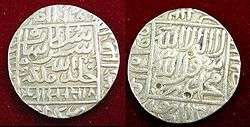
The word "rupee" is derived from a Sanskrit word "rūpya", which means "wrought silver", and maybe also something stamped with an image or a coin.[4] As an adjective it means "shapely", with a more specific meaning of "stamped, impressed", whence "coin". It is derived from the noun rūpa "shape, likeness, image".
Panini used rūpya to mean beautiful or stamped (ahāta). The second meaning applies to a coin.[8] Kasikakara expands upon this, these coins that stamped were the Dinara, Kedara and Karshapana. The term Rupataraka is mentioned by Patanjali in reference to one who checks the Karshapana coins. An early Pali scripture uses the term Mashaka-rupa, Mashaka being a token Karshapana. The term was no longer in much use to refer to a coin in later eras. In the Rajatarangini, uses the term rupakas for gold coins, they are called svarna-rupakas. The Kathasaritsagara calls the gold Dinar coins svarna-rupakas.[3]
Arthashastra, written by Chanakya, prime minister to the first Maurya emperor Chandragupta Maurya(c. 340–290 BCE), mentions silver coins as rūpyarūpa, other types of coins including gold coins (suvarṇarūpa), copper coins (tāmrarūpa) and lead coins (sīsarūpa) are also mentioned. Rūpa means form or shape, example, rūpyarūpa, rūpya – wrought silver, rūpa – form.[1]
In the intermediate times there is no fixed monetary system as reported by the Da Tang Xi Yu Ji.[9]
During his five-year rule from 1540 to 1546, Sher Shah Suri set up a new civic and military administration and issued a coin of silver, weighing 178 grains, which was also termed the Rupiya.[4][6] The silver coin remained in use during the Mughal period, the Maratha era (1674–1818)[7] and in British India, as well.
Coinage since the British period

The British settlements in Western India, South India, and the Eastern Province of Bengal (Calcutta) independently developed different coinages in consonance with the local acceptability of the coins for the purposes of trade.
-4037.jpg)
-4038.jpg)

There are many fake coins of East India Company, with Indian gods depicted on the obverse side as shown in side-bar. Original East India Company coins show only the coat of arms of the East India Company.
The coins of Bengal were developed in the Mughal style and those of Madras mostly in a South Indian style. The English coins of Western India developed along Mughal as well as English patterns. It was only in 1717 AD that the British obtained permission from the Emperor Farrukh Siyar to coin Mughal money at the Bombay mint. The British gold coins were termed Carolina, the silver coins Anglina, the copper coins Cupperoon and tin coins Tinny. By early 1830, the British had become the dominant power in India. The Coinage Act of 1835 provided for uniform coinage throughout India. The new coins had the effigy of William IV on the obverse and the value on the reverse in English and Persian. The coins issued after 1840 bore the portrait of Queen Victoria. The first coinage under the crown was issued in 1862 and in 1877 Queen Victoria assumed the title the Empress of India. The gold silver ratio expanded during 1870–1910. Unlike India, her colonial master Britain was on the gold standard. To meet the Home Charges (i.e., expenditure in England) the colonial government had to remit a larger number of rupees and this necessitated increased taxation and unrest.
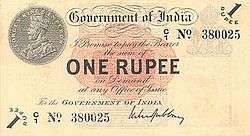
The 1911 accession to the throne of the King-Emperor George V led to the famous "pig rupee". On the coin, the King appeared wearing the chain of the Order of the Indian Elephant. Through poor engraving, the elephant looked very much like a pig. The Muslim population was enraged and the image had to be quickly redesigned.
Acute shortage of silver during the First World War, led to the introduction of paper currency of One Rupee and Two and a half Rupees. The silver coins of smaller denominations were issued in cupro-nickel. The compulsion of the Second World War led to experiments in coinage where the standard rupee was replaced by the "Quaternary Silver Alloy". The Quaternary Silver coins were issued from 1940. In 1947 these were replaced by pure Nickel coins.
Immediately after independence, the British coinage was continued. The Monetary System remained unchanged at One Rupee consisting of 64 pice, or 192 pies.
The "Anna Series" was introduced on 15 August 1950. This was the first coinage of the Republic of India. The King's Portrait was replaced by the Ashoka's Lion Capital. A corn sheaf replaced the Tiger on the one Rupee coin. The monetary system was retained with one Rupee consisting of 16 Annas. The 1955 Indian Coinage (Amendment) Act, that came into force with effect from 1 April 1957, introduced a "Decimal series". The rupee was now divided into 100 'Paisa' instead of 16 Annas or 64 Pice. The "Naye Paise" coins were minted in the denominations of 1, 2, 5, 10, 20 and 50 Naye Paise. Both the Anna series and the Naye Paise coins were valid for some time. From 1968 onward, the new coins were called just Paise instead of Naye Paise because they were no more naye = new.
With high inflation in the sixties, small denomination coins which were made of bronze, nickel-brass, cupro-nickel, and aluminium-bronze were gradually minted in Aluminium. This change commenced with the introduction of the new hexagonal 3 paise coin. A twenty paise coin was introduced in 1968 but did not gain much popularity.
Over a period, cost-benefit considerations led to the gradual discontinuance of 1, 2 and 3 paise coins in the 1970s. Stainless steel coinage of 10, 25 and 50 paise, was introduced in 1988 and of one rupee in 1992. The very considerable costs of managing note issues of Rs 1, Rs 2, and Rs 5 led to the gradual coinisation of these denominations in the 1990s.
Since 1947
Since its Independence in 1947, India has faced two major financial crises and two consequent devaluations of the rupee: In 1966 and 1991.[10]
Decimalisation
A summary of the decimalisation of the Rupee:[11]
| Dates | Currency system |
|---|---|
| From 1835 | 1 rupee = 16 annas =64 pice (paisé – singular, "paisa") = 192 pies (singular, "pie") |
| From 1 April 1957 | 1 rupee = 100 nayé paisé |
| From 1 June 1964 | 1 rupee = 100 paisé |
The price of 16 Annas is 05 rupee in 1947. The demand for decimalisation existed for over a century. Sri Lanka decimalised its rupee in 1869. The Indian Coinage Act was amended in September 1955 for the adoption of a decimal system for coinage. The Act came into force with effect from 1 April 1957. The rupee remained unchanged in value and nomenclature. It, however, was now divided into 100 'Paisa' instead of 16 Annas or 64 Pice. For public recognition, the new decimal Paisa was termed 'Naya Paisa' until 1 June 1964 when the term 'Naya' was dropped. The coins of that period also mentioned their value in terms of the rupee to avoid confusion and cheating. For example, the one paisa coin carried the text "One-hundredth of a Rupee" in Hindi.
1966 Economic crisis
From 1950, India ran continued trade deficits that increased in magnitude in the 1960s. Furthermore, the Government of India had a budget deficit problem and could not borrow money from abroad or from the private corporate sector, due to that sector's negative savings rate. As a result, the government issued bonds to the RBI, which increased the money supply, leading to inflation. In 1966, foreign aid, which had hitherto been a key factor in preventing devaluation of the rupee, was finally cut off and India was told it had to liberalise its restrictions on trade before foreign aid would again materialise. The response was the politically unpopular step of devaluation accompanied by liberalisation. Furthermore, The Indo-Pakistan War of 1965 led the US and other countries friendly towards Pakistan to withdraw foreign aid to India, which necessitated more devaluation. Defense spending in 1965/1966 was 24.06% of total expenditure, the highest it has been in the period from 1965 to 1989 (Foundations, pp 195). Another factor leading to devaluation was the drought of 1965/1966 which resulted in a sharp rise in prices.
At the end of 1969, the Indian Rupee was trading at around 13 British pence. A decade later, by 1979, it was trading at around 6 British pence. Finally, by the end of 1989, the Indian Rupee had plunged to an all-time low of 3 British pence. This triggered a wave of irreversible liberalisation reforms away from populist measures.
1991 Economic crisis
In 1991, India still had a fixed exchange system, where the rupee was pegged to the value of a basket of currencies of major trading partners. India started having the balance of payments problems since 1985, and by the end of 1990, it found itself in serious economic trouble. The government was close to default and its foreign exchange reserves had dried up to the point that India could barely finance three weeks’ worth of imports. As in 1966, India faced high inflation and large government budget deficits. This led the government to devalue the rupee.[12]
At the end of 1999, the Indian Rupee was devalued considerably.
Revaluation
In the period between 2000 and 2007, the Rupee stopped declining and stabilised ranging between 1 $ = Rs 44– Rs 48. In late 2007, the Indian Rupee reached a record high of 39 Indian national rupee per United States dollars, on account of sustained foreign investment flows into the country. This posed problems for major exporters, IT and BPO firms located in the country who were incurring losses in their earnings given the appreciation in rupee. The trend has reversed lately with the 2008 world financial crisis as Foreign investors transferred huge sums out to their own countries. Such appreciations were reflected in many currencies, e.g. the British sterling pounds, which had gained value against the dollar and then has lost value again with the recession of 2008.
2013 Depreciation
Due to stagnant reforms, and declining foreign investment, rupee started depreciating in the early 2013.[13] Measures were announced by the government before this drop to prevent it from dropping further, but none managed to slow down the depreciation.[14] After continued depreciation, and high inflation, the then Prime Minister of India, Manmohan Singh, made a statement in the Parliament of India on the issue. He was of the view that, the present depreciation is partly led by global factors as well as domestic factors. He also asked the political parties to help his Government, tide over the crisis that the country was facing with rupee losing its value.[15]
2016 Demonetisation
2016 saw the discontinuation of ₹500 and ₹1,000 notes due to the 2016 Indian bank note demonetisation and consequently the introduction of new a ₹500 note, and a ₹2,000 note- a first for the currency. Later on, new notes of old denominations viz. ₹10, ₹20, ₹50 and ₹100 were issued with old notes of the same value still being legal tender. A ₹200 note, also a first for the Indian Rupee, is currently in circulation.
Banknotes
Early paper issues
Notes issued by the Bank of Bengal can be categorised in the following three series.
- Unifaced series: The early notes of the Bank of Bengal were printed only on one side and were issued as one gold mohur and in denominations of Rs. 100, Rs. 250, Rs. 500, etc.
- Commerce series: Later notes had a vignette representing an allegorical female figure personifying 'commerce'. The notes were printed on both sides. On the obverse the name of the bank and the denominations were printed in three scripts, viz., (Urdu, Bengali and Devanagari). On the reverse of such notes was printed a cartouche with ornamentation carrying the name of the Bank.
- Britannia series: By the late 19th century, the motif 'commerce' was replaced by 'Britannia'. The new banknotes had more features to prevent forgery.
British India issues
The Paper Currency Act of 1861 gave the Government the monopoly of note issue throughout the vast expanse of British India, which was a considerable task. Eventually, the management of paper currency was entrusted to the Mint Masters, the Accountant Generals and the Controller of Currency.
- Victoria portrait series: The first set of British India notes were the 'Victoria Portrait' series issued in denominations of Rs 10, Rs 20, Rs 50, Rs 100 and 1,000. These were unifaced, carried two language panels. The security features incorporated the watermark, the printed signature and the registration of the notes.
- Underprint series: The unifaced Underprint series was introduced in 1867 as the Victoria Portrait series was withdrawn in the wake of a spate of forgeries. These notes were issued in denominations of Rs 5, Rs 10, Rs 20, Rs 50, Rs 100, Rs 500, Rs 1,000 and Rs 10,000.
- George V series: A series carrying the portrait of George V were introduced in 1923, and was continued as an integral feature of all paper money issues of British India. These notes were issued in denominations of Rs 1, Rs 2 1⁄2, Rs 5, Rs 10, Rs 50, Rs 100, Rs 1,000, and Rs 10,000.
Reserve Bank issues during British India
The Reserve Bank of India was formally inaugurated on Monday, 1 April 1935 with its Central Office at Calcutta. Section 22 of the RBI Act, 1934, empowered it to continue issuing Government of India notes until its own notes were ready for issue. The bank issued the first five rupee note bearing the portrait of George VI in 1938. This was followed by Rs. 10 in February, Rs 100 in March and Rs 1,000 and Rs 10,000 in June 1938. The first Reserve Bank issues were signed by the second Governor, Sir James Taylor. In August 1940, the one-rupee note was reintroduced as a wartime measure, as a Government note with the status of a rupee coin. During the war, the Japanese produced high-quality forgeries of the Indian currency. This necessitated a change in the watermark. The profile portrait of George VI was changed to his full frontal portrait. The security thread was introduced for the first time in India. The George VI series continued till 1947 and thereafter as a frozen series till 1950 when post-independence notes were issued.
Republic of India issues
Following the Independence of India the Government of India brought out the new design Re.1 note in 1949. Initially, it was felt that the King's portrait is replaced by a portrait of Mahatma Gandhi. Finally, however, the Lion Capital of Ashoka was chosen. The new design of notes were largely along earlier lines. In 1953, Hindi was displayed prominently on the new notes. The economic crisis in the late 1960s led to a reduction in the size of notes in 1967. High denomination notes, like Rs. 10,000 notes were demonetized in 1978.
The first "Mahatma Gandhi Series" was introduced in 1996. Prominent new features included a changed watermark, windowed security thread, latent image and intaglio features for the visually handicapped.
The five hundred (₹500) and one thousand rupee notes (₹1,000) were demonetised by an unscheduled address to the nation by Prime Minister Narendra Modi starting from midnight 8 November 2016.[16] These notes are being replaced by the Mahatma Gandhi New Series of notes.
Valuation history
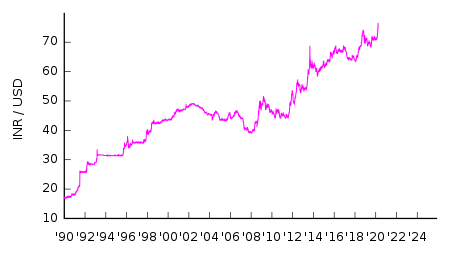
The rupee was never equal to the dollar. At the time of independence (in 1947), India's currency was pegged to pound sterling, and the exchange rate was a shilling and six pence for a rupee — which worked out to Rs 13.33 to the pound.[17] The dollar-pound exchange rate then was $4.03 to the pound, which in effect gave a rupee-dollar rate in 1947 of around Rs 3.30.[18][19] The pound was devalued in 1949, changing its parity from 4.03 to 2.80. India was then a part of the sterling area, and the rupee was devalued on the same day by the same percentage so that the new dollar exchange rate in 1949 became Rs 4.76 — which is where it stayed till the rupee devaluation of 1966 made it Rs 7.50 to the dollar and the pound moved to Rs 21. [20][21]
| Year | Exchange rate (INR per USD) |
|---|---|
| 1947 | 3.30[18] |
| 1949 | 4.76[20] |
| 1966 | 7.50[21] |
| 1975 | 8.39[22] |
| 1980 | 6.61[23] |
| 1985 | 12.38[23] |
| 1990 | 17.01[23] |
| 1995 (Jan) | 37.69 |
| 2000 (Jan) | 44.31[23] |
| 2005 (Jan) | 43.50[23] |
| 2006 (Jan) | 46.92 [23] |
| 2007 (Jan) | 49.32 [23] |
| 2008 (Jan) | 43.30 |
| 2009 (1 Jan) | 48.82 |
| 2010 (January) | 46.02 |
| 2011 (1 Jan) | 44.65 [24] |
| 2012 (1 Jan) | 53.06 [25] |
| 2013 (1 Jan) | 54.78 [26] |
| 2014 (1 Jan) | 61.86 [27] |
| 2014 (15 May) | 59.44 [28] |
| 2014 (12 Sep) | 60.95[29] |
| 2015 (15 Apr) | 62.30[30] |
| 2015 (15 May) | 64.22 |
| 2015 (19 Sep) | 65.87 |
| 2015(30 Nov) | 66.79 |
| 2016(20 Jan) | 68.01 |
| 2016(25 Jan) | 67.63 |
| 2016(25 Feb) | 68.82 |
| 2016 (14 April) | 66.56 |
| 2016 (22 Sep) | 67.02 |
| 2016 (24 Nov) | 67.63 |
| 2017 (28 Mar) | 65.04 |
| 2017 (28 April) | 64.27 |
| 2017 (15 May) | 64.05 |
| 2017 (14 August) | 64.13 |
| 2017 (24 October) | 64.94 [31] |
| 2018 (9 May) | 64.80 |
| 2018 (5 Oct) | 74.09 |
| 2018 (9 Oct) | 74.35 |
| 2018 (22 Oct) | 73.66 |
| 2018 (13 Nov) | 72.56 |
| 2018 (4 Dec) | 70.6403[32] |
| 2019 (6 Jan) | 69.53 |
| 2019 (12 Jan) | 70.37[33] |
| 2019 (1 Feb) | 71.44 |
| 2019 (10 July) | 68.374 |
| 2019 (13 Nov) | 72.1512[34] |
| 2020 (15 Jan) | 70.724 |
| 2020 (6 March) | 74.00[35] |
| 2020 (21 April) | 76.97[35] |
| 2020 (15 June) | 75.94[36] |
Other issues
In Mozambique the British India rupees were overstamped, and in Kenya the British East Africa company minted the rupee and its fractions as well as pice. It was maintained as the florin, using the same standard, until 1920. In Somalia the Italian colonial authority minted 'Rupia' to exactly the same standard, and called the paisa 'besa'. Early 18th-century E.I.C. rupees were used in Australia for a limited period.
- Jammu and Kashmir issues: Maharaja Rambir Singh introduced paper money on watermarked paper in 1877. The notes were not very popular and were in circulation for a very short period. The notes carried the 'Sun' motif of the Dogra family.
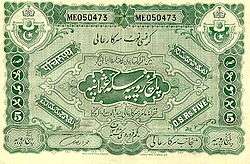

- Hyderabad issues: The Government of Hyderabad had made several efforts to organize private bankers to set up a banking company which could issue paper money. The British, however, resisted the attempts of Indian princely states to issue paper currency. The acute shortage of silver during the First World War and the contributions of Hyderabad State to the British war effort led them to accept, in 1918, paper currency in denominations of Rs.10/- and Rs.100/- issued under the Hyderabad Currency Act. The currency was designated the Osmania Sicca (OS). Rupee One and Rupees Five notes were issued subsequently in 1919 and Rupees One Thousand notes were issued in 1926. After the setting up of the India Currency Notes Press at Nasik, Hyderabad notes came to be printed there.
- Burma issues: Burma separated from India in 1938; however, the Reserve Bank of India acted as Banker to the Government of Burma and was responsible for note issue in terms of the Burma Monetary Arrangements Order, 1937. In May 1938 the Bank issued Burma notes which were not legal tender in India.
- Indo-French issues: The French Indian rupee (FIR) was introduced by France's Bank of Indochina in French colonies of India.
- Indo-Portuguese issues : The Portuguese Indian Rupia was the currency of Portuguese India until 1959. It was divisible into 16 Tangas or 960 Reis. In 1959, the currency was changed to the Portuguese Indian Escudo, at the rate of 1 Rupia for 6 Escudos.
- Persian Gulf issues: For many years in the early and mid-20th century, the Indian rupee was the official currency in several areas that were controlled by the British and governed from India: areas such as East Africa, Southern Arabia and the Persian Gulf. The rupees used in the Persian Gulf had been bought by the Gulf states from the Reserve Bank of India, who held the sterling reserves by which the rupees had originally been purchased. However, Indian rupees were being smuggled from India to the states of the Persian Gulf in exchange for gold. It was estimated in 1959 that the total amount of gold in private hands in India was about $US1.75 to 2 billion – roughly two-thirds of the value of paper money in circulation. While it was legal to own and to trade in gold within India, it was illegal to import or export gold. The Gulf Rupee, also known as the Persian Gulf Rupee (PGR), was introduced by the Indian government as a replacement for the Indian Rupee for circulation exclusively outside the country with the Reserve Bank of India Amendment Act, 1 May 1959. After India devalued the rupee on June 1966, those countries still using it – Oman, Qatar and what is now the United Arab Emirates (known as the Trucial States until 1971) – replaced the Gulf Rupee with their own currencies. Kuwait and Bahrain had already done so in 1961 and 1965 respectively.
- Emergency issues, Princely states: During the 1940s, when mints were occupied for use in the war, an acute scarcity of small coins was felt throughout India. Princely states in Western India like Balvan, Bikaner, Bundi, Gondal, Indergadh, Junagadh, Jasdan, Kutch Mengni, Muli, Morvi, Mangrol, Nawanagar, Nawalgarh Palitana, Rajkot, Sailana, Sayla, Vithalgadh, issued "Cash Coupons" to meet the shortage.
 Hyderabad state OS Rs. 100 issue
Hyderabad state OS Rs. 100 issue Five rupees, 1922
Five rupees, 1922- Portuguese Indian 1 rupee, 1924
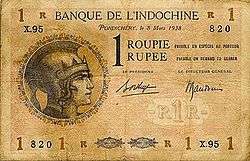 French Indian 1 rupee, 1938
French Indian 1 rupee, 1938 George VI profile portrait, RBI, 1937
George VI profile portrait, RBI, 1937 One rupee, British India
One rupee, British India George VI profile portrait changed to frontal portrait, RBI, 1943
George VI profile portrait changed to frontal portrait, RBI, 1943
See also
- Tables of historical exchange rates to the india rupee
- The Revised Standard Reference Guide to Indian Paper Money
- Rupee
- Indian rupee
- Mauritian rupee
- Pakistani rupee
- Nepali rupee
- Coinage of India
- Coins of British India
- History of the taka
References
- Redy. "AIndia.htm". Worldcoincatalog.com. Retrieved 20 June 2013.
- Richard Seaford (January 2002). Tragedy, Ritual and Money in Ancient Greece: Selected Essays. Cambridge University Press. p. 1599. ISBN 9781107171718.
- D. R. Bhandarkar (1990). Lectures on Ancient Indian Numismatics. Asian Educational Services. pp. 129–132. ISBN 9788120605497.
- etymonline.com (20 September 2008). "Etymology of rupee". Retrieved 20 September 2008.
- Trübner’s Oriental Series DA TANG XIYU JI Great Tang Dynasty Records of the Western World, translated by Samuel Beal TWO VOLUMES Kegan, Paul, Trench, Teubner & Co. London • 1906 [First Edition ‐ London • 1884]
- Mughal Coinage Archived 16 May 2008 at the Wayback Machine at RBI Monetary Museum. Retrieved on 4 May 2008.
- "Coinage - Pre-Colonial India Coinage". Rbi.org.in. Retrieved 20 June 2013.
- Radhakumud Mookerji (1966). Chandragupta Maurya and His Times. Motilal Banarsidass. ISBN 9788120804050.
- Trübner’s Oriental Series DA TANG XIYU JI Great Tang Dynasty Records of the Western World, translated by Samuel Beal TWO VOLUMES Kegan, Paul, Trench, Teubner & Co. London • 1906 [First Edition ‐ London • 1884]
- Devika Johri & Mark Miller. "Devaluation of the Rupee: Tale of Two Years, 1966 and 1991" http://www.ccs.in/ccsindia/policy/money/studies/wp0028.pdf Archived 26 June 2013 at the Wayback Machine
- "Global Financial Data". Global Financial Data. 15 September 2011. Retrieved 20 June 2013.
- "Devaluation of the Rupee: Tale of Two Years, 1966 and 1991" (PDF). Archived from the original (PDF) on 29 March 2007. Retrieved 4 September 2012.
- Rupee crashes to 68.75 per dollar as foreign investors flee - NDTVProfit.com. Profit.ndtv.com. Retrieved on 1 December 2013.
- Bhat, Swati. (28 August 2013) Rupee nears 69/dollar; posts biggest day fall in 18 years | Reuters. In.reuters.com. Retrieved on 1 December 2013.
- External factors led to rupee fall, reduce hunger for gold: PM. YouTube (30 August 2013). Retrieved on 1 December 2017.
- Spotlight (8 November 2016), [English]PM Modi's Surgical Strike on Corruption | 500,1000 Rupee Notes Not Legal Tender Anymore, retrieved 8 November 2016 – via YouTube
- says, Ronak Shah (23 January 2017). "Dispelling Myths about India's Finances post Independence". CA. Nirmal Ghorawat's Blog. Retrieved 13 January 2019.
- "USD Rates in 1947 to 2018 | US Dollar to INR History | 1 USD Against INR". Blog-Best Foreign Exchange. 4 October 2017. Retrieved 13 January 2019.
- "Busting the myth: Re 1 was not equal to $1 in 1947". Moneycontrol. Retrieved 13 January 2019.
- http://www.moneycontrol.com/news/business/busting-the-myth-re-1-was-not-equal-to-1-in-1947-2359873.html
- http://www.rediff.com/business/slide-show/slide-show-1-column-why-the-supposed-rupee-dollar-parity-of-1947-is-a-myth/20130819.htm
- Journey of Indian rupee since independence, The Times of India. Retrieved on 1 December 2013.
- Trading Economics
- Exchange Rates
- "USD to INR Rates on 1/01/2012". Exchange Rates. 1 January 2012. Retrieved 20 June 2013.
- "USD to INR Rates on 1/01/2013". Exchange Rates. 15 May 2013. Retrieved 20 June 2013.
- Exchange Rates|date= 1 Jan 2014
- "USD to INR Rates on 15-May-2014". Exchange Rates. 15 May 2014. Retrieved 15 April 2015.
- "USD to INR Rates on 12-Sep-2014". Exchange Rates. 12 September 2014. Retrieved 15 April 2015.
- "USD to INR Rates on 15-Apr-2015". Exchange Rates. 15 April 2015. Retrieved 15 April 2015.
- "news18". 14 August 2017. Retrieved 14 August 2017.
- "US Dollar (USD) to Indian Rupee (INR) exchange rate history". www.exchangerates.org.uk. Retrieved 13 January 2019.
- "US Dollar (USD) to Indian Rupee (INR) exchange rate history". www.exchangerates.org.uk. Retrieved 13 January 2019.
- "US Dollar to Indian Rupee Spot Exchange Rates for 2019". www.exchangerates.org.uk. Retrieved 8 May 2020.
- "US Dollar to Indian Rupee Spot Exchange Rates for 2020". www.exchangerates.org.uk. Retrieved 8 May 2020.
- "Dollar to Rupee Exchange Rate 15-Jun-2020". Exchange Rates. 15 June 2020. Retrieved 15 June 2020.